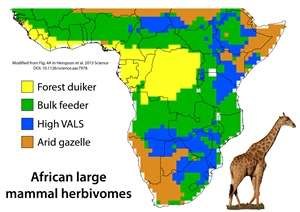A team of local scientists have wound back the clock by 1000 years to reconstruct wildlife populations across Africa to help us better understand how they have shaped the world we live in.
This is important, because to understand the ecology of Africa, and much of the rest of the globe, you have to include animals – and now we have the means to do so, says lead researcher Dr Gareth Hempson, also a postdoctoral researcher at the School of Animal, Plant and Environmental Sciences at Wits University.
Hempson, together with Professor Sally Archibald (Wits University) and Professor William Bond (University of Cape Town), have published a paper in Science, an international journal, titled: A continent-wide assessment of the form and intensity of large mammal herbivory in Africa.
"Animals matter and ecologists across the world are starting to realise that many ecosystems cannot be understood without including animals and their impact into their thinking," says Hempson.
"The problem is that in most places, natural wildlife populations are extinct. The challenge that we took up was to try and bring them back."
Africa works
Hempson says Africa is the only place left where they could conduct this study because there are fewer cases of extinction here. There are many protected areas where animal populations are still intact in Africa. The team focused on large mammal herbivores – plant-eating animals like antelope, zebra, elephants, rhino and pigs. These mammals form an integral level in the food pyramid, both consuming vegetation and themselves being consumed by carnivores.
"We used wildlife census data from as many of these protected areas as possible, and then analysed how factors like rainfall, soil fertility and vegetation types influenced the abundance of different species.
"With that information and the knowledge about what rainfall, soils and vegetation used to be like – we were able predict how many animals of each species there were in all the places that are now so radically transformed," Hempson explains.
The researchers recognised 'herbivory regimes' across Africa. Dry areas – where there is not much food and very wet areas – where the food is almost all out of reach in the forest canopy and had relatively few animals. The in-between areas, says Hempson, are really interesting. "They are your classic African savannas." The drier savannas are packed with a kaleidoscope of African wildlife, and the wetter savannas are dominated by elephants and fire.
"All those patterns are of themselves really interesting, and lend strong support to previous ideas about the large-scale ecology of Africa. But there is much more that we can do with this new information," says Hempson.
How does this help us?
- This research provides a platform for fitting animals into the global ecosystem models that are used to predict where planet Earth is headed.
- It allows us to look outside of Africa – for example towards South America – and compare the ecology of our continent with one that lost its big animals thousands of years ago. It raises questions such as: Did they help shape their own ecology, so that the world changed when they were lost, or were they merely passive users of ecosystems shaped by climate and soils?
- It also lets us explore the evolution of animal-associated groups like thorny plants, or dung beetles, because we can now make sense of their current distributions that were shaped by animals in the past.
- Back in Africa, livestock have replaced wildlife over vast areas. This research will bring us closer to answering where has this occurred? What are the implications of this shift? Are they simply interchangeable, or are there consequences for how ecosystems work?
More information: G. P. Hempson et al. A continent-wide assessment of the form and intensity of large mammal herbivory in Africa, Science (2015). DOI: 10.1126/science.aac7978
Journal information: Science
Provided by Wits University
























